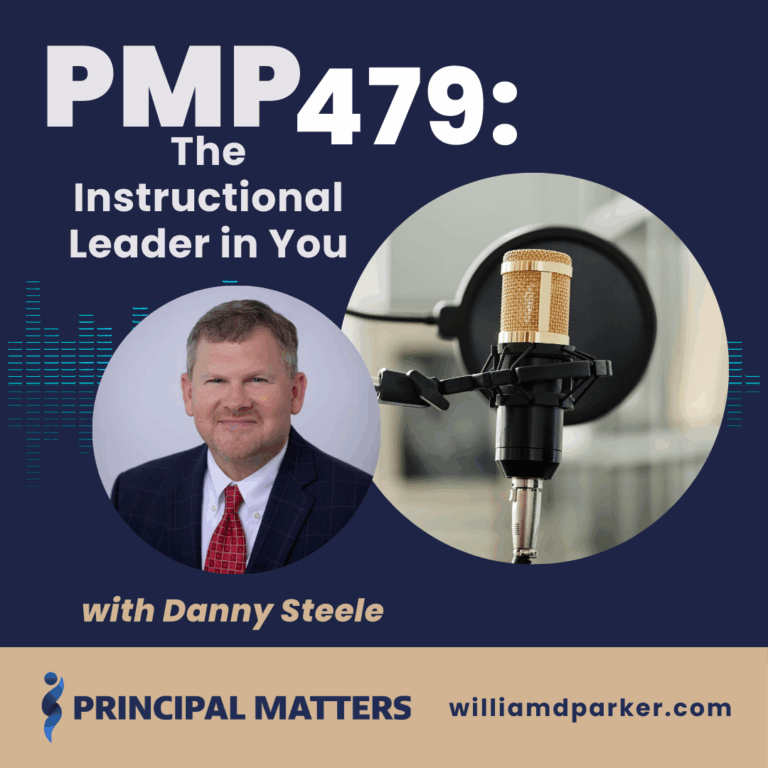Podcast: Play in new window | Download
During my second year as a high school assistant principal, I received notice one morning that a number of students were missing items from their lockers.
Upon further investigation, we discovered that in one hallway of the school, an entire row of lockers had broken into and contents were missing from several. Thankfully, we had cameras in that section of the building, and I began watching tape – rewinding from the time school was dismissed the day before and viewing until the morning of the report.
I finally found footage of several students late the evening before, and I could see them breaking into the lockers. It was during evening credit-recovery classes we offered, and the students seemed to be on what appeared to be a bathroom break and had chosen a hallway where the lights were off.
For the most part, all I could see were their silhouettes. Throughout the day, I pulled in some of my staff and team members who helped me match descriptions with the names on evening class roll. After our day-time students went home that day, I stayed late to talk to the teacher in charge of evening classes and to meet one-on-one with each student suspected of being involved.
Luckily, as I questioned students one-on-one, most were cooperative and admitted to what happened. But one young lady was not cooperative. I’ll call her Lizzy. As I talked to Lizzy about what I had observed on camera, she insisted she wasn’t involved. She certainly matched the physical traits of what I could see in the video, so I switched into “interrogator’ assistant principal mode:
“Listen, Lizzy.” I said, “I know it’s hard to admit when you’ve done something wrong, but not cooperating is not going to help as talk about appropriate consequences for breaking into lockers.” Lizzy began to cry. “I promise it wasn’t me, Mr. Parker.” So, I asked her to take a seat in the office waiting area and think about her actions as I still had other students to question.
I’ll come back to that conversation at the end of this post, but I was thinking about that day recently when talking to new principals about how to manage student discipline.
The Challenge of Managing Behavior
I believe student discipline is often the hardest and most difficult part of a school leader’s work. Because I served as an assistant principal for nine years before becoming a high school principal, I spent a lot of time managing hundreds if not thousands of student discipline scenarios. At first, the pressure involved in decisions that were often so emotional for students or parents, was overwhelming.
When you are managing difficult discipline scenarios, you also spend very little of that time on other important matters – like classroom observations or scheduled team meetings. Although the tasks of managing behavior never become “easy,” I do believe relying on best practices can help over time.
Great Resource for New School Leaders
A great resource I’ve pointed principals toward lately is Jen Schwanke’s You’re the Principal, Now What? Strategies and Solutions for New School Leaders, published in 2016.
In her chapter on student discipline, she shares some helpful and practical tips, including:
• Empowering your teachers in student discipline
• Clarifying that when problems reach you, you take the lead in deciding discipline
• Knowing your districts student handbook and policies
• Differentiating discipline
• Prioritizing student safety
• Investigating situations fully
• Letting time be your friend
• Getting second opinions
• Avoiding group consequences
• Involving parents whenever possible (Schwanke, 160-166)
I highly recommend her book for the many other scenarios and challenges faced by new school leaders.
7 Tips for Communicating While Managing Student Discipline
In previous posts and in my books, I share suggestions on how to communicate during student discipline that may help you in your practice. Here are seven to keep in mind:
1. Communicate in writing (importance of handbooks)
When you know your policies and procedures ahead of time, and have them in writing, you have a strong guide for school-wide expectations and enforcement. Handbooks don’t replace wise decision-making, but without them you will be open to inconsistent or litigious practice. So know the ground-rules and make sure they are clear in writing.
2. Communicate in person (power of presentations)
Students need to see and hear from face-to-face about what your expectations are for their behavior. This is why I’m a big fan of small group meetings with students at the start of each school year. It takes more time in large student populations, but you not only communicate consistent expectations in-person, but also you have the opportunity to look into the eyes of students and build rapport.
3. Communicate consistently (pre-determine consequences and rewards)
Students thrive in environments where they know what is expected and then see those expectations enforced firmly, fairly, and consistently. This is best done when you’ve already decided ahead of time what actions to take for common and expected misbehaviors. Keep consequences closely tied to level of student safety involved.
4. Communicate to parents (before, during, and after discipline)
Parents are likely to partner with you when you keep them informed along the way. When they hear from you often through other positive means, they are also more likely to trust and support your decisions. When dealing with student discipline, especially, keeping them informed is an important part of being on the same page.
5. Communicate with superiors (eliminate surprises for upper admin)
In addition to students and parents, your administrative supervisors usually like to be in-the-know when it comes to discipline – especially situations they may also have to address.
6. Communicate with your team (keeping your staff in the loop)
Sometimes principals fail to let teachers know important information about student discipline. Although some information must be kept confidential, a student’s teachers normally see him or her on a more consistent basis than you. If a teacher has referred a student to you, he or she will normally be curious or anxious to know if the situation was managed. Do the courtesy to keep them informed when appropriate.
7. Communicate for future reference (documentation for reports)
If you don’t write it down, it didn’t happen – or at least you may be held liable later that it didn’t. Documentation takes time and can be a hassle, but good documentation provides you with consistent reporting, follow-up, and records for any future questions or concerns.
What does research say about school discipline?
Dr. Sameer Hinduja is a Professor in the School of Criminology and Criminal Justice at Florida Atlantic University and Co-Director of the Cyberbullying Research Center. Last month I heard him speak about his research on school culture at AMLE’s national conference for middle school educators in Orlando, Florida. You can see all his resources at his website.
In research of schools and the kinds of environments where students feel most secure in learning, Dr. Hinduja shared three models for comparison:
1. Permissive models – These are schools that are low on discipline but high on social emotional support.
2. Authoritarian models – These are schools that are high on discipline and low on social emotional support.
3. Authoritative models – These are schools that are high on discipline and high on social emotional support.
You’ve probably already guessed the most effective – where students and teachers feel most safe: The Authoritative: High Discipline and High Support Model. In this model, 97% of surveyed students feel safe – a significant difference in comparison to the other two models.
The biggest takeaway from Dr. Hinduja’s presentation for me was that strong cultures take both strong discipline and strong student support. It’s just like strong parenting: you must consistently implement and enforce expectations while also providing strong emotional and social support for students to learn and thrive.
Let’s Wrap This Up
Let’s go back to my first story: As Lizzy waited outside my office during my locker investigations, I called in more students for questioning. One boy, in particular, began to list the other students who had participated breaking into lockers. As he talked, he mentioned a female student I did not have on my list. I pulled up the video footage, and this time I realized she was the young woman I thought was Lizzy.
Needless to say, it was long, exhausting evening, as I interviewed students, called parents, retrieved missing items, and assigned appropriate school discipline. Of course, the evening instructor and I also talked about appropriate supervision. But I had something else important to do: When I called Lizzy back in my office, guess what I did next? I apologized.
“Lizzy,” I said, “I’m so sorry I wrongly accused you and then didn’t believe you when you told me truth. I feel horrible for putting you through this situation and hope you can forgive me.”
To my surprise, Lizzy said, “It’s okay, Mr. Parker. I know it must be hard doing your job and we all make mistakes.”
And you know what, Lizzy was right. You have a hard job.
Whether it is instructional leadership, school culture, student supervision, or organizational planning – you have a lot on your plate. And school discipline is one of the hardest parts. But as you think about the importance of an “authoritative” culture – one that holds students to high standards, communicates those expectations, enforces them consistently, and maintains the dignity of students in the process — then you have the ability to build a school community where students feel safe to learn and sometimes still trust you even when you screw up.
You will never do the work of leadership perfectly. Give yourself some grace, reach out to others who can help, do the best you can with practices that work, and when you mess up, apologize and move on. When it comes to student discipline, know that in the end, these best practices generally produce strong cultures for student learning and growth.
Now It’s Your Turn
Think about the authoritative, authoritarian, and permissive models. What kind of culture do you think your students or teachers would say is practiced at your school? How can you revisit your practices with your team to ensure high expectations and high support are both happening? What is one step you can take to model that approach today?
More Resources
For other posts I’ve shared on discipline, you can check out: 7 tips for dealing with challenging students, or 8 tips for disciplining with dignity.
Sign-Up For Free Updates and Ebook
When you enter your email address here, you will automatically receive my newest posts and a free Ebook, 8 Hats: Essential Roles for School Leaders. Let’s keep learning together!
Principal Matters–The Book!
School leaders are very busy, so each of the twenty-four chapters is designed as a quick-read and followed with take-action questions for follow-up or reflection. If you want practical ideas on understanding your purpose, managing school teams, dealing with challenges, and leading with courage, action, motivation, and teamwork, go HERE to pick up a copy for you or your team.
Messaging Matters
Harness the power of messaging to create a culture of acknowledgment, respect, and celebration. Written specially for leaders, this title is divided into three parts, helping readers to maximize their role as chief communicators with students, teachers, and parents and community. Each chapter includes suggestions for using digital tools to enhance messaging and ends with reflection questions and practical next steps.




